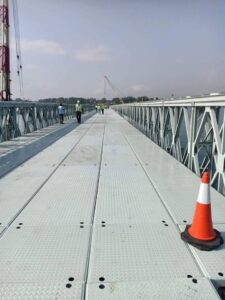By Nuru Salim
In December 2020, Kenya introduced the Likoni Floating Bridge, an ambitious project that began on the 18th of July, aiming to transform daily commutes across the Likoni Channel in Mombasa.
The 1.2-kilometer bridge, which held the title of Africa’s longest floating bridge was designed to offer safe passage for thousands of pedestrians daily.
Hailed as an engineering marvel, the bridge provided an alternative to the crowded Likoni ferry services, promising enhanced connectivity between Mombasa Island and the mainland.
But four years later, Kenyans still ask a distressing question: What happened to the Likoni Footbridge?
Built with an innovative design that allowed it to float on the channel’s surface, the bridge became an icon of hope for improved pedestrian safety and traffic decongestion.
However, despite its early promise, the bridge soon encountered operational setbacks that have left many questioning its purpose.
The bridge’s operational challenges were apparent even shortly after its launch.
While designed to divert a significant portion of pedestrian traffic from the ferries, reports indicate that authorities began redirecting pedestrians back to the ferry services during an incoming cargo vessel and off-peak hours.
This decision met with confusion undermining the very purpose of the bridge and significantly reducing its utility.
Critics argue that the bridge, while ambitious, was perhaps rushed without thorough consideration of the challenges it would face.
Many critics claim that the bridge was a bold move but without proper analysis of environmental factors and long-term usage patterns, it was bound to struggle.
Adding to the list of grievances, the said bridge’s design was rumored to have restricted commercial vessels, an issue that sparked further doubt from the government who rely on the channel for import-export business.
As the bridge’s utility lapsed, residents are now calling on county and national leaders to reassess pedestrian transport options across the Likoni Channel as relying on ferries alone turns out to be a challenge.
The Likoni Floating Bridge was, at its core, a noble idea and a step toward a safer, more accessible Mombasa. But as Kenyans now look for answers on its whereabouts, the questions still linger.
For a long time now, Mombasa’s residents have continued their commute, with many returning to the familiar ferries that the Likoni Floating Bridge had once been meant to replace while others use the Dongo Kundu bypass to escape the ferry ”tragedy”.


